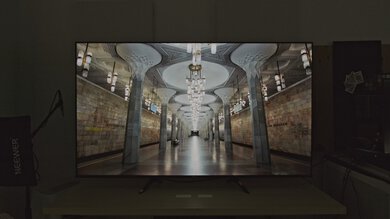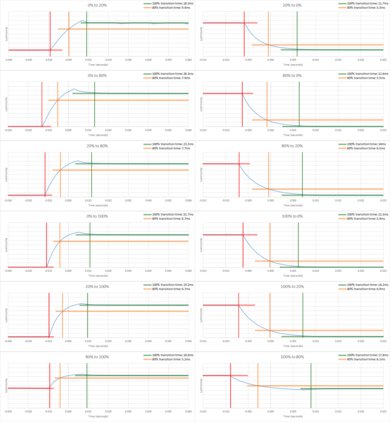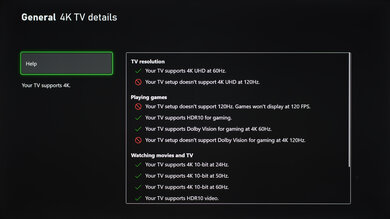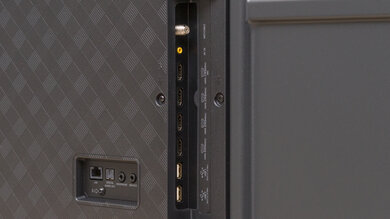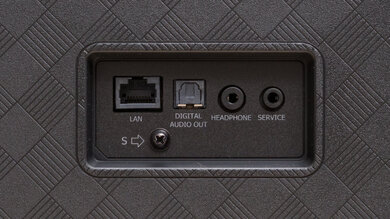The Hisense A6G is an entry-level 4k TV from Hisense's 2021 TV lineup. Like some of their higher-end ULED models, it comes with Android TV built-in, a user-friendly platform with many apps you can download. The mic built into the remote gives you access to the Google Assistant or Alexa voice assistant features, allowing you to search for content and quickly open apps. It's available in a wide range of sizes, from 43 to 85 inches, but the exact performance depends on which size you get. It's a pretty basic TV without many extra features like eARC or HDR10+ support. However, it's one of a few TVs with a composite adapter so that you can connect old devices like a DVD player or an early-generation gaming console.
Our Verdict
The Hisense A6G is an okay TV overall. The wide viewing angle and decent reflection handling make it a decent choice for watching shows during the day, but it isn't bright enough to fight glare in a well-lit room. It's also okay for watching sports as its motion handling is okay. It doesn't have advanced gaming features, but its input lag is low, so the overall gaming experience isn't bad. Unfortunately, it's poor for watching movies in dark rooms because it has a low native contrast ratio and sub-par black uniformity. It also doesn't get bright enough to make highlights stand out in HDR.
- Upscales low-resolution content well.
- Image remains accurate at an angle.
- Huge selection of streaming apps.
- Mediocre contrast.
- No local dimming.
- Not very bright.
The Hisense A6G is poor for watching movies in a dark room. It has a low contrast ratio, so blacks look gray in a dark room, and it has sub-par black uniformity that results in blooming and clouding throughout. It can't improve either, as it lacks a local dimming feature. On the flip side, it upscales low-resolution content well and can remove judder from native apps or native 24p sources.
- Upscales low-resolution content well.
- Very little stutter.
- Huge selection of streaming apps.
- Mediocre contrast.
- No local dimming.
- Sub-par black uniformity.
The Hisense A6G is a decent TV for watching shows during the day. It has a good viewing angle, so you'll see a consistent image as you move off to the sides. It upscales lower resolution content well, so cable TV channels look great, and the built-in Google Play Store has a huge selection of streaming apps, so you're guaranteed to find something to watch. Although it has decent reflection handling, it isn't bright enough to fight glare in bright rooms.
- Upscales low-resolution content well.
- Image remains accurate at an angle.
- Huge selection of streaming apps.
- Not very bright.
The Hisense A6G is okay for watching sports. It has a good viewing angle, making it a good choice for watching the big game with a large group of friends, and it upscales cable sports well, with no noticeable issues. It also has a huge selection of streaming apps if you stream your sports. Although it has decent reflection handling, it isn't bright enough to fight glare from bright lights if you watch sports during the day.
- Upscales low-resolution content well.
- Image remains accurate at an angle.
- Huge selection of streaming apps.
- Not very bright.
- Just okay response time.
The Hisense A6G isn't bad for gaming. It has a fairly slow response time, so fast-moving objects are a bit blurry, but there isn't a ton of blur trail either. It also has low input lag for a responsive feel while gaming. Sadly, it's limited to a 60Hz refresh rate and doesn't support advanced gaming features like variable refresh rate (VRR) support. Also, the low contrast and lack of a local dimming feature mean this isn't the best choice for late-night gaming in a dark room as blacks look gray.
- Low input lag for gaming.
- No local dimming.
- Sub-par black uniformity.
- Just okay response time.
The Hisense A6G delivers a bad HDR movie experience. It has a mediocre contrast, so blacks look gray in a dark room, and there's no local dimming feature to improve it. It has low peak brightness in HDR, so small highlights don't stand out. It doesn't display a wide range of colors in HDR either, so colors don't look vivid, and it doesn't deliver a satisfying HDR experience.
- Very little stutter.
- Mediocre contrast.
- Bad HDR peak brightness.
- No local dimming.
- Sub-par black uniformity.
The Hisense A6G is unremarkable for HDR gaming. Gaming on it isn't bad as it has low input lag and an okay response time, but some motion still looks blurry. However, it doesn't support any advanced gaming features for high-frame-rate gaming. Also, HDR looks bad as it has a low contrast that makes blacks look gray, lacks a local dimming feature, and doesn't make colors and highlights look vivid.
- Low input lag for gaming.
- Mediocre contrast.
- Bad HDR peak brightness.
- No local dimming.
- Sub-par black uniformity.
- Just okay response time.
The Hisense A6G is a great choice for a PC monitor. It has a wide viewing angle, so the edges of the screen remain consistent if you're sitting close to it. It also has low input lag, ensuring cursor movements feel responsive. On the other hand, the response time is just okay as there can be some noticeable blur. It also has decent reflection handling but isn't bright enough to use in a well-lit office space.
- Image remains accurate at an angle.
- Low input lag for gaming.
- Decent reflection handling.
- Not very bright.
- Just okay response time.
Changelog
- Updated Nov 20, 2024: We uploaded the latest brightness measurements and uniformity photos for the Accelerated Longevity Test.
- Updated Sep 11, 2024: We uploaded the latest brightness measurements and uniformity photos for the Accelerated Longevity Test.
- Updated Jul 17, 2024: We uploaded the latest brightness measurements and uniformity photos for the Accelerated Longevity Test.
- Updated May 02, 2024: We uploaded the latest brightness measurements and uniformity photos for the Accelerated Longevity Test.
Check Price
Differences Between Sizes And Variants
We tested the 65-inch Hisense A6G, and the results are also valid for the 43-inch model (Hisense 43A6G), the 55-inch model (Hisense 55A6G), and the 75-inch model (Hisense 75A6G). The 50-inch (Hisense 50A6G), 60-inch (Hisense 60A6G), 70-inch (Hisense 70A6G), and 85-inch (Hisense 85A6G) models are a bit different, as they use a different panel type from the 65-inch we've tested, so the results from this review aren't valid for those models.
There are similar models available in the US, known as the A6GX Series TVs, but they're different because they use a different operating system. In Canada, this model is the Hisense A68G, and the results are also valid for it. As Hisense's lineup differs in other countries, the results aren't valid for any similarly-named models internationally.
| Size | US Model | Canada Model | Panel Type | HDMI Ports |
|---|---|---|---|---|
| 43" | 43A6G | 43A68G | IPS | 4 |
| 50" | 50A6G | 50A68G | VA | 4 |
| 55" | 55A6G | 55A68G | IPS | 4 |
| 60" | 60A6G | 60A68G | VA | 3 |
| 65" | 65A6G | 65A68G | IPS | 4 |
| 70" | 70A6G | 70A68G | VA | 3 |
| 75" | 75A6G | 75A68G | IPS | 4 |
| 85" | - | 85A68G | VA | 4 |
If someone comes across a different type of panel or their Hisense A6G doesn't correspond to our review, let us know, and we'll update the review. Note that some tests like the gray uniformity may vary between individual units.
The unit of the Hisense A6G we reviewed was manufactured in February 2021, and you can see the label here.
Popular TV Comparisons
The Hisense A6G is an okay budget TV but has limited features and just okay picture quality. It's an okay choice for a secondary display in a bedroom or office, but there are much better options available within the same price range.
See our recommendations for the best 4k TVs, the best small TVs, and the best smart TVs.
The Hisense U6G is better than the Hisense A6G overall, but as they use different panel technologies, the A6G might be a better choice for some people. The U6G uses a VA panel, resulting in much better contrast and better black uniformity, making it the better choice for a dark room. The A6G uses an IPS panel, so it might be a better choice if you have a wide seating arrangement, as the image remains accurate at an angle.
The Samsung TU7000 and the Hisense A6G use different panel technologies, each with strengths and weaknesses. The Samsung is a better choice for a dark room, as its VA panel has better contrast and black uniformity. The Hisense, on the other hand, is a better choice for a wide seating arrangement, as the image remains accurate when viewed at an angle.
The Hisense A6G and the Hisense A6H are very similar overall. The more recent A6H runs a newer smart interface, known as Google TV 11, instead of the older Android TV platform. It's a bit more polished and easy to use. The A6H also supports variable refresh rate technology, which helps improve the overall gaming experience by reducing visible tearing in some games. As far as overall picture quality goes, there's very little difference between these two TVs.
The Hisense U6N is much better than the Hisense A6G. HDR content looks much better on the U6N due to its wider color gamut for more vibrant colors and its better HDR brightness for more impactful highlights. Whether you're watching SDR or HDR content, the U6N looks much better in a dark room thanks to its local dimming feature, which greatly increases the TV's contrast and allows it to display much deeper blacks. The U6N also looks better in a bright room due to its ability to overcome more glare. Finally, the U6N is the better gaming TV due to its VRR support, quicker response time, and support for up to 1440p @ 120Hz.

We buy and test dozens of TVs yearly, taking an objective, data-driven approach to deliver results you can trust. Our testing process is complex, with hundreds of individual tests that take over a week to complete. Most of our tests are done with specially designed test patterns that mimic real content, but we also use the same sources you have at home to ensure our results match the real-world experience. We use two main tools for our testing: a Colorimetry Research CR-100 colorimeter and a CR-250 spectroradiometer.
Test Results

The Hisense A6G has a very similar design to the Hisense U6G and Hisense U8G. The thin bezels and sleek design are nice for a budget model. Some of the larger sizes have a slightly different design, mainly with the back panel.
Sadly, the stand doesn't support the screen all that well, and there's noticeable wobble. While it has a wide footprint, you can also move the feet inwards for smaller tables.
Footprint of the 65-inch model as shown: 50.3" x 11.7". The alternate position, as shown here, has a footprint of 25.2" x 11.7". Regardless of which configuration you choose, the TV sits 3.1 inches above the table, so most soundbars should fit without blocking the TV.
The back is metal on the top and plastic on the bottom section. The inputs face to the side, but because they're towards the center, they can be hard to reach, especially if you have it wall-mounted. There are tracks on the back for cable management, but they don't hold the cables very well.
Some of the models of the Hisense A6G, like this one, have a mediocre contrast ratio. It results in blacks that look gray in a dark room, and it doesn't have a local dimming feature to improve it. The 50, 60, 70, and 85-inch models have a different panel type with a better contrast.
The Hisense 65A6G has poor peak brightness in SDR. It isn't bright enough to overcome glare in a bright living room and is best suited for a room with low levels of lighting.
These results are from after calibration in the 'Theater Night' Picture Mode with the Backlight Level set to 'Max'. Changing the Picture Mode to 'Standard' and setting Active Contrast to 'High' results in a slightly brighter image, but it isn't as accurate.
The Hisense A6G doesn't have a local dimming feature. The video is for reference only, so you can see how the local dimming feature on other displays compares to one without local dimming. It's a direct-lit LED TV, which means that the backlights are placed directly behind the screen, which is different from edge-lit TVs and isn't the same as local dimming.
The Hisense A6G doesn't have a local dimming feature. The video is for reference only, so you can see how the local dimming feature on other displays compares to one without local dimming. It's a direct-lit LED TV, which means that the backlights are placed directly behind the screen, which is different from edge-lit TVs and isn't the same as local dimming.
The Hisense 65A6G has poor peak brightness in HDR. It isn't bright enough to show off highlights in HDR, and without a local dimming feature, small highlights don't pop against the rest of the screen. It follows the target PQ curve fairly well for dark scenes, but there's a sharp roll-off at the peak brightness, causing a loss of fine details in bright scenes.
These results are in the 'HDR Theater' Picture Mode. Unfortunately, this is also as bright as the TV gets. Even with the Picture Mode set to 'HDR Standard', the peak brightness is about the same, but some darker scenes are boosted a bit, as shown in this EOTF.
There's no difference in this TV's peak brightness in or out of Game Mode, which is great. These results are with the same settings as outside of Game Mode, but with the Picture Mode set to 'HDR Game'.
The Hisense A6G has excellent gradient handling. There's very little banding in areas of similar color. Although this TV has Noise Reduction and Digital Noise Reduction features, they don't improve the gradient handling and can cause a loss of fine details in high-quality content.
This TV has okay gray uniformity. The edges of the screen are noticeably darker than the rest, which can be distracting if you want to use it as a PC monitor. There's also dirty screen effect in the center, which is noticeable during sports.
The Hisense A6G Series has a good viewing angle. The image remains consistent as you move off to the side, making it a good choice for wide seating areas. However, the 50, 60, 70, and 85-inch models have a worse viewing angle, so they aren't good for wide seating areas.
The Hisense A6G has decent reflection handling. The semi-gloss coating doesn't disperse reflections very well, so direct reflections are very noticeable and can be distracting. It handles moderate amounts of light well, but considering it doesn't get bright, it's best to avoid placing it in a bright room.
The out-of-the-box accuracy is okay. The white balance isn't very accurate as almost all shades of gray have noticeable inaccuracies. The color temperature is cool, giving everything a bluish tint, and some saturated colors are off too. Finally, gamma doesn't follow the 2.2 target for a moderately-lit room as most scenes are brighter than they should be.
The Hisense A6G Series has fantastic accuracy after calibration to the D65 white point. The white balance was difficult to calibrate, but it's extremely accurate. Gamma is much closer to the target, and most colors are accurate. The color temperature is still a bit cool, but it isn't very noticeable.
You can see our full calibration settings here.
The Hisense A6G displays native 4k content perfectly, with no noticeable issues. Unlike the Hisense H6570G, there aren't any issues with crosshatching.
The RGB subpixel layout is ideal for PC use as many programs support it, and text looks clear. However, the models with VA panels have a BGR subpixel layout, which could negatively impact text clarity when using it as a PC monitor. However, it isn't a big issue, and it doesn't affect the overall picture quality. You can read more about it here.
The Hisense A6G has an okay color gamut for HDR. It displays a good amount of colors in the commonly-used DCI-P3 color space with good tone mapping, meaning most colors appear as they should. However, it isn't future-proof as it has limited coverage of the Rec. 2020 color space with bad tone mapping, so colors are inaccurate.
The Hisense A6G has a poor color volume. It's limited by the narrow color gamut, and due to the low contrast ratio, it can't display dark saturated colors.
Although some IPS and similar panels can suffer from temporary image retention, this doesn't appear to be permanent as seen in our long-term test.
This TV has an okay response time. There's very little difference in the pixel response time between different transitions; they're all just okay. It results in some noticeable blur behind fast-moving objects. The backlight flicker also causes image duplication.
The backlight isn't flicker-free as it uses pulse-width modulation to dim the backlight. The backlight flickers at a fixed frequency when you set the backlight to anything below its max. It causes noticeable duplications in motion and may bother you if you're sensitive to flicker.
The Hisense A6G TV doesn't have an optional backlight strobing feature to reduce persistence blur, and it always flickers at 180Hz, which can be distracting as it causes image duplications.
This TV doesn't have a motion interpolation feature.
Due to the relatively slow response time, there isn't much stutter when displaying movies or other low frame-rate content.
The Hisense A6G automatically removes 24p judder from native 24p sources like apps and Blu-ray players, which helps with the appearance of motion in movies. However, it can't do it from sources that don't have a Match Frame Rate feature, like a cable box.
This TV doesn't support any variable refresh rate technologies to reduce screen tearing when the frame rate of your game drops.
The Hisense A6G has fantastic low input lag, resulting in a very responsive gaming experience. Even outside of Game Mode, the input lag is reasonable, and you won't feel much of a delay when scrolling through the TV's interface.
This TV supports most common resolutions at 60Hz. It also displays proper chroma 4:4:4 with all of its supported resolutions, which helps result in clear text during PC use. It supports 1440p, but you need to force a custom resolution from your PC.
Although this TV doesn't support any advanced gaming features or a 120Hz input, it does have Auto Low Latency Mode. If you enable Content Type Auto Detection, the TV automatically switches to Game Mode when it detects a game being played from a supported source, resulting in low input lag.
Unlike many other TVs, it comes with a composite adapter, which is great if you have older gaming consoles or DVD players.
There's no eARC support, so it can't passthrough the highest quality audio formats like Dolby Atmos or DTS:X.
This TV has a disappointing frequency response. The low-frequency extension (LFE) is very high, resulting in almost no bass response. Above the LFE, the sound profile is fairly well-balanced at moderate volume, resulting in clear dialogue. Unfortunately, there's a bit of compression at max volume.
The Hisense A6G has good distortion performance. There's very little difference between moderate and max volume levels.
Unlike the higher-end 2021 Hisense TVs, the Hisense A6G runs Android TV 9. The Android TV interface is fast and fairly easy to use, and we didn't experience any bugs or unexcepted freeze-ups.
Unfortunately, like almost all TVs on the market, there are ads throughout the home page, although we couldn't capture a picture of one. There are rows of suggested content as well, and although there's an option to opt-out, this replaces them with random ads that aren't based on your history.
The Hisense A6G comes with the same remote as the Hisense U6G. It has six shortcut buttons for your favorite streaming services, and the built-in mic gives quick access to Alexa or Google Assistant. You can use the voice controls to change inputs, launch apps, or search for content, but you can't use them to change picture settings on the TV.












